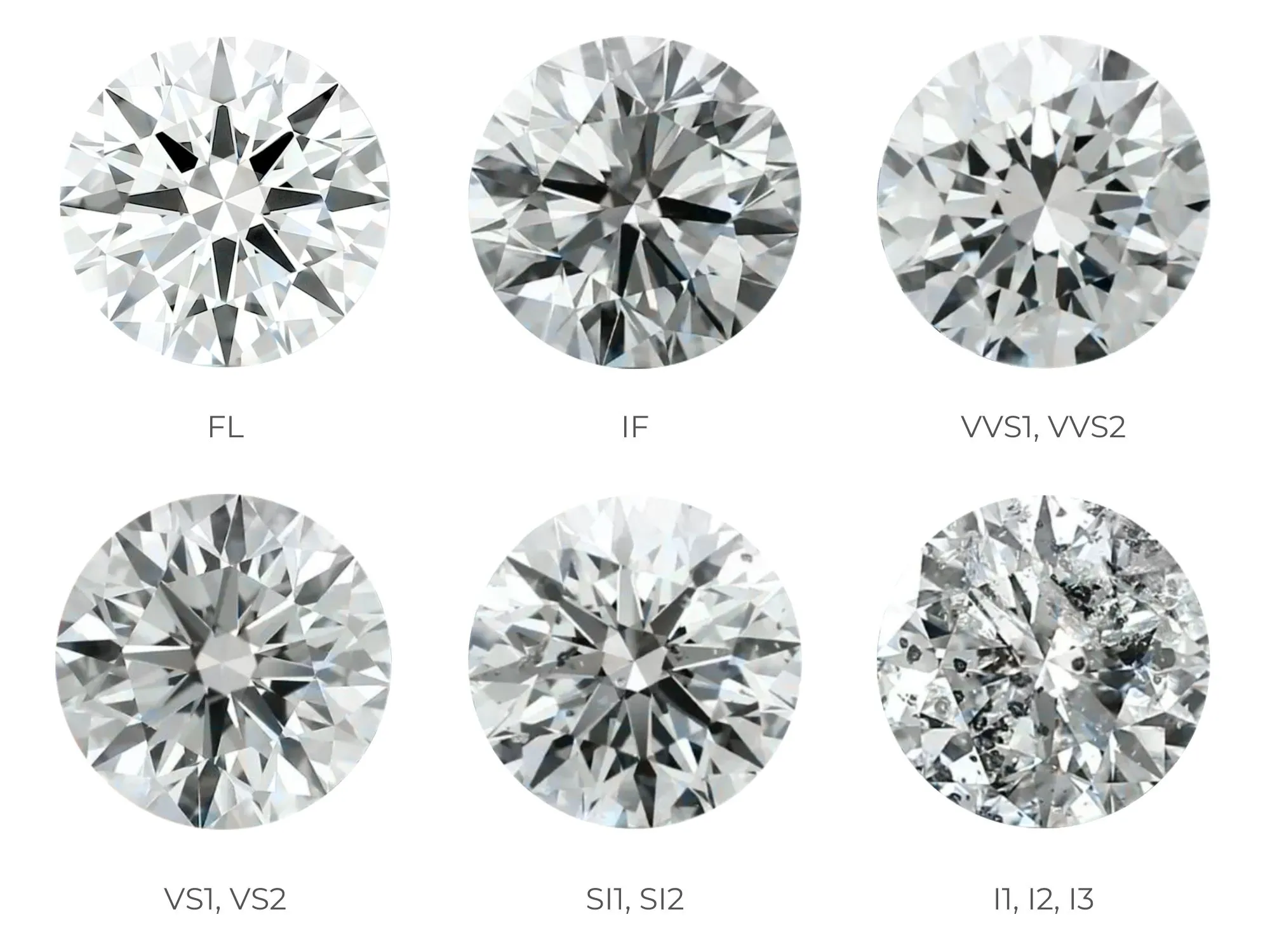Understanding Diamond Clarity: A Complete Guide
When choosing a diamond, one of the essential factors to consider is clarity. Diamond clarity refers to the presence of internal or external imperfections in a diamond, which can affect its overall appearance, sparkle, and value. In this guide, we’ll explain the clarity scale, types of inclusions, and how clarity affects a diamond’s brilliance and price, helping you make an informed decision when purchasing a diamond.
1. What is Diamond Clarity?
Diamond clarity measures the number, size, nature, and position of imperfections, often called “inclusions” (internal flaws) and “blemishes” (external flaws). These imperfections form naturally and are unique to each diamond. Since diamonds form under intense heat and pressure, most have some degree of inclusions, which can range from hardly visible to noticeable.
2. The GIA Clarity Scale
The Gemological Institute of America (GIA) developed the most widely used diamond clarity grading scale, which classifies diamonds into the following categories:
FL (Flawless)
- Characteristics: Absolutely no visible inclusions or blemishes when viewed under 10x magnification.
- Rarity and Value: Very rare and highly valued. Only a tiny percentage of diamonds are graded FL.
- Price Range: These are often priced at a premium due to their rarity.
IF (Internally Flawless)
- Characteristics: No internal flaws but may have minor surface blemishes, which don’t affect appearance.
- Rarity and Value: Almost as rare as FL diamonds and also command high prices.
- Price Range: Slightly lower than FL diamonds but still in the top pricing tier.
VVS1 and VVS2 (Very, Very Slightly Included)
- Characteristics: Very tiny inclusions that are challenging to spot even under 10x magnification.
- Rarity and Value: Both grades are rare and highly desirable for their near-flawless appearance.
- Price Range: Slightly more affordable than FL and IF diamonds but still priced higher than most lower clarity grades.
VS1 and VS2 (Very Slightly Included)
- Characteristics: Inclusions are small and usually difficult to see without magnification.
- Rarity and Value: A popular choice for balancing clarity and price, as inclusions are hard to spot and don’t generally impact sparkle.
- Price Range: More affordable than VVS diamonds but still high quality and typically beautiful to the naked eye.
SI1 and SI2 (Slightly Included)
- Characteristics: Inclusions are visible under 10x magnification and may be slightly visible to the naked eye, especially in larger stones.
- Rarity and Value: SI diamonds offer good value for their appearance and price.
- Price Range: More affordable than higher-clarity diamonds, often appealing for budget-conscious buyers.
I1, I2, and I3 (Included)
- Characteristics: Inclusions are visible to the naked eye and can affect transparency and sparkle.
- Rarity and Value: These diamonds are the most affordable but have visible inclusions that may detract from their appearance.
- Price Range: The lowest clarity grade and therefore the most budget-friendly, but the flaws are typically noticeable.
3. Types of Inclusions and Blemishes
There are several common types of inclusions and blemishes that clarity graders evaluate, each affecting clarity in different ways:
- Pinpoints: Small white or black dots that are difficult to see.
- Feathers: Small cracks or fractures within the diamond that may look like tiny feathers.
- Clouds: Groups of pinpoints that can make a diamond appear hazy.
- Crystals: Small mineral crystals within the diamond, which can be black, white, or even colored.
- Cavities: Tiny holes in the diamond, usually caused during the polishing process.
- Graining: Lines within the diamond that may look like internal white or reflective lines.
Each type of inclusion can impact a diamond’s brilliance differently, depending on its location and size.
4. How Clarity Affects Diamond Sparkle and Appearance
While clarity is important, inclusions may not always be visible, especially in diamonds graded VS2 or higher. The placement of inclusions also matters; those closer to the edges are less noticeable and can often be hidden by prongs or settings. Smaller, well-placed inclusions can have minimal impact on sparkle, while larger or centrally located ones may affect brilliance.
Diamonds with lower clarity grades (SI1, SI2, and I1) may still appear beautiful, especially in smaller carat sizes where inclusions are less noticeable. In many cases, choosing a diamond with slight inclusions that don’t affect the sparkle can allow you to invest more in other qualities, like carat or cut.
5. Choosing the Right Clarity Grade for Your Budget
Your budget and personal preferences will play a major role in determining the best clarity grade for you:
- High Budget: If you’re looking for the best of the best, aim for FL or IF grades. These diamonds are rare and nearly flawless, making them ideal for those who prioritize clarity and rarity.
- Balanced Budget: For a balance of beauty and value, VS1 and VS2 diamonds offer excellent quality without the premium price of higher grades. They appear “eye-clean,” meaning inclusions are rarely visible without magnification.
- Budget-Friendly Options: SI1 and SI2 diamonds offer excellent value and are often eye-clean, especially in smaller sizes. Choosing a diamond in this clarity range can help you achieve a larger carat size or a higher cut grade without compromising on quality.
6. The Importance of Personal Inspection and Certification
Since each diamond is unique, it’s always recommended to view your diamond in person or through high-resolution images when shopping online. Look for a diamond with a certification from reputable gemological labs like GIA or AGS to ensure accurate grading and transparency.
A diamond’s clarity grade is just one part of the overall quality. Depending on your preference, you might prioritize other factors, such as cut, carat, or color, to find a diamond that fits your style and budget.
